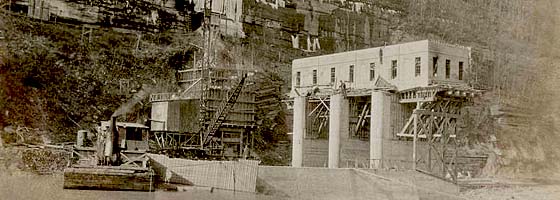History
To facilitate the use of the river as a transportation corridor, various projects throughout the 1800s attempted to improve navigation on the river with limited success. In 1836, the Commonwealth of Kentucky constructed Locks 1 through 5; however, by 1884, Locks and Dams 1 through 5 were in complete disrepair and had to be rebuilt by the U.S. Army Corps of Engineers. By 1917, Locks 1 through 14 were in service to create year-round navigable pools from Beattyville to Carrollton. The locks provided passage for boats under most water conditions; however only small barges were able to navigate the relatively shallow, meandering river.
The Kentucky River Navigation system, locks and dams, is one of the oldest still operating in the United States. Lock and Dam No.7 was constructed in 1897 by the U.S. Army Corps of Engineers (“ACOE”) and is located at river mile 117, near High Bridge at the end of Kentucky route 29. Lock and Dam 7 is a timber-crib dam with a stone lock chamber built in 1896-97 by the ACOE for barge navigation. At one end of the dam is the Mother Ann Lee Hydroelectric Station Hydroelectric Project (FERC Project No. 539).
This run-of-river project utilizes the Kentucky River Authority (KRA) owned Lock and Dam 7 to generate electricity. The plant was designed by L.F. Harza, and was built by the L.E. Myers Co. The Project was completed in 1928. A license for the Project was originally issued to the Kentucky Hydro Electric Company on August 19, 1926, and was transferred to Kentucky Utilities Co. (KU) effective December 31, 1928. The plant and Federal Energy Regulatory Commission (FERC) license were transferred to Lock 7 Hydro Partners, LLC on December 30, 2005. The plant was originally named the “Lock 7 Plant”. Its name was changed to the Mother Ann Lee Hydroelectric Station when the FERC license was transferred to Lock 7 Hydro Partners, LLC.
The plant was operated from 1928 until the 1990’s by Kentucky Utilities (KU), when problems with the generating units forced them out of service. On April1, 2004, KU filed an “Initial Consultation Document” stating its intent to decommission the Lock 7 Plant and surrender to FERC license for the project. Upon this action, Soft Energy Associates (SEA) began discussion with KU on the purchase of the project with the intent of renovating the plant. KU and SEA entered into an exclusive agreement that allowed for a due diligence evaluation of the site. SEA was encouraged by the comments that KU received from the public and environmental groups requesting that the plant be renovated by KU or sold to someone else that would save this clean renewable energy plant. In December 2004, KU and SEA signed a “Letter of Intent” to purchase to plant. SEA created a corporation, Shaker Landing Hydro Associates, Inc. (SLHA) specifically to renovate the plant. To strengthen its proposal to renovate the plant, SLHA formed a 50/50 partnership with Salt River Electric, a rural electric cooperative in Bardstown, KY. This partnership, named Lock 7 Hydro Partners, LLC, purchased the Lock 7 plant from KU in December 2005.
